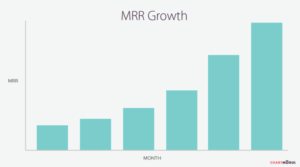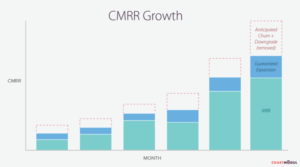We’ve previously discussed the crucial metrics CFOs should know — now it’s time to tackle the specific applications of these metrics, focusing primarily on CMRR.
MRR vs. CMRR: Which One Should You Use?
As important as MRR is for measuring your predictable revenue streams, it won’t be able to give you the clear, long-term forecast that CMRR can. This is because CMRR also accounts for expected churn during the tracking period, whereas with MRR, you won’t have insight into anticipated cancellations or upgrades and downgrades, instead only being able to observe the company’s gross revenue. For instance, if you have a high churn rate, relying on MRR alone can give you a rather unpleasant surprise upon review. You’ll want to make sure that you’re moving your MRR/ARR towards the net positive, and CMRR is a valuable tool for determining this.
Moreover, CMRR is not only useful for your company internally — banks also use these figures as a baseline for how much credit to lend at certain time periods. Not to mention, that your CMRR is what investors would be looking into when gauging your company’s potential for long-term expansion.
CMRR can be calculated using this formula:
Existing MRR + Signed Contracts – Expected Churn = CMRR
The CMRR calculation can be further broken down to the following components:
- Guaranteed Recurring Revenue Portion of the New MRR – the known recurring revenue portion becoming a part of the recognized recurring revenue stream
- Guaranteed Recurring Revenue Portion of Expansion MRR – the expected contracted upgrade of a subscription after a certain period of time
- Guaranteed Recurring Revenue Portion of Contraction MRR – the expected downgrade of a subscription leading to imminent churn
Suppose that today is September 15th and you’ve already determined your recognized MRR for August, with your known upgrades, downgrades, and new subscriptions for the past month already accounted for. Let’s say your August MRR is $700K. During this specific period, you’ve started receiving new mid-cycle bookings, cancellation requests, etc.
Your CMRR will be computed as an extension of your recognized MRR in August, and will include the new subscriptions, upgrades and downgrades, and cancellations that have yet to flow into your revenue stream, giving you real-time figures and a more precise income projection. The same concept applies if you’re selling annual contracts, the only difference being that you use your ARR as the basis.
Here’s a visual representation of the comparison of MRR and CMRR from ChartMogul:




Contracted MRR vs. Committed MRR: Are They Different?
The terms Contracted MRR and Committed MRR are almost identical and are often used interchangeably, only having a slight difference if applied to term-based subscription businesses.
In the case of term-based subscription businesses, the contracted MRR includes only the contractually guaranteed revenues computed from the recognized revenue derived from new bookings until their terms end. The non-recurring revenues would be excluded from the contracted or committed revenue. For example, imagine a customer subscribes to wireless broadband services for $49.99 per month, with a one-time installation fee of $20. The guaranteed portion of the recurring revenue is $49.99 monthly, while the one-time charges of $20 won’t be included in the CMRR.
Final Thoughts
Tracking your CMRR helps lay the foundation for growth as it gives you accurate insights into the real financial standing of your business. It helps you improve your cash flow alignment, saves you time in managing your recurring revenues, and keeps your business on the right track as it scales.
Photography by Chris Liverani via Unsplash


